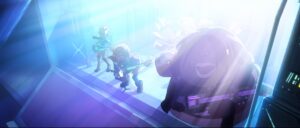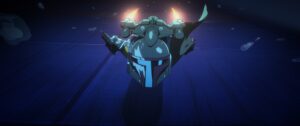If you enjoy what you read below – we hope you’ll join us to read the full Visions article and the rest of the issue by subscribing to Backstory Magazine!
Backstory was given the opportunity to exclusively interview the filmmakers behind four of the groundbreaking shorts featured in Star Wars Visions. Below, TATOOINE RHAPSODY director Taku Kimura gives the details behind his rock musical. (Note: All answers were given in Japanese and translated to English.)
By Danny Munso
No short better represents the ambitious and adventurous nature of Visions more than Studio Colorido’s “Tatooine Rhapsody.” Directed by Taku Kimura, the film manages to feel like Star Wars and at the same time like nothing we’ve ever seen in the canon. The story follows a lost Jedi named Jay uniting with Geezer — an estranged member of the Hutt clan — to form a rock band called Star Waver. The short even closes with a full musical performance that gets even Jabba the Hutt’s considerably large tail tapping. Though music is no stranger to Star Wars, which has featured multiple musical acts throughout its history, including Figrin D’an and the Modal Nodes in A New Hope and the Max Rebo Band in Return of the Jedi. But no fictional band had ever explored rock, and that’s the genre Kimura wanted to hit with Star Waver. “I believed the rock genre and the spirit of rebellion in rock music would function well as part of the story,” he says. “So it was planned as a musical from the beginning. Visions called for freely imagined projects so I started thinking about the stories of people living in far corners of the galaxy instead of depicting the main Star Wars story about the battle between the Jedi and Sith. I realized I could produce something that was different from anything else by featuring musicians.”

One of the key areas in which “Tatooine Rhapsody” diverges from the rest of the Visions shorts is its inclusion of existing canonical Star Wars characters, albeit in a supporting role. As mentioned, Jabba himself makes an appearance as he imprisons Geezer, an outcast member of his family who turned his life on a life of crime to start the band. And who does Jabba send to bring in Geezer? None other than his bounty hunter of choice, Boba Fett. For Kimura, the inclusion of these legacy characters was a continuation of what Lucasfilm has been doing with their recent series such as The Mandalorian and The Bad Batch, which feature notable cameos from important characters in Lucas’ original six films in the franchise. “Paying homage to prior works in the Star Wars series and having guest appearances would create a link to a variety of elements in the Star Wars universe,” he says. “This is something that has been really enjoyable in the recent Star Wars output. Visions is no exception, and the inclusion of those elements is important when making a Star Wars production. It was surprising that the other shorts in Visions did not feature existing characters.” As Visions executive producer and Lucasfilm SVP of franchise content and strategy James Waugh told Backstory in issue 44, the execs at Lucasfilm were so enthralled with the originality of Kimura’s pitch they didn’t hesitate to allow him to include those characters. “That idea is so original it almost earned the right to fit those characters into the wider Star Wars universe a little bit,” Waugh said.
Kimura’s original idea for the short followed the same general pitch — a Jedi forms a band — but took on a very different tone and was set in the aftermath of Order 66, where the Jedi were hunted down and slaughtered to launch the reign of the Empire. It also would have featured a cameo from a Jedi of note. “Jay had formed a band to earn some money while hiding in his hometown,” Kimura says of his abandoned idea. “One day he is chased down after his identity is discovered by the Empire, and he sets out for Tatooine to get help from his old friend Obi-Wan Kenobi.” In this version, Jay’s music serves as a rebellious act against the Empire, and the song he and the band perform encourages people to rise up against the regime ruling the galaxy. Kimura thought that waded into territory already covered in other Star Wars projects. “Jay stirred people’s emotions by performing a kind of anti-Imperialist song with his band, but the pattern felt the same as other works about an immature Padawan who grows up to fight against the Empire. Instead, we strengthened the themes of his passion for music and his desire to play with his friends rather than fight, which is what led us to where we are.”

That’s not to say there isn’t any political iconography involved in “Tatooine Rhapsody.” Though the Empire is absent from the short, Jay’s journey in that original story mirrors Geezer’s in the finished version. These are characters turning away from violence to make music. To hammer home this strong thematic point, Kimura credits screenwriter Yasumi Atarashi for producing the beautiful image of Jay turning his lightsaber into the microphone he uses when performing with the band. It’s such a unique plot point that Kimura admits to hesitating before approving it for the short. “It was a brilliant idea that Yasumi came up with,” he says. “When I first heard it, I thought, Won’t the fans be angry if we turn the lightsaber into a microphone? But it very clearly expresses the theme of choosing the path of music rather than war. And visually it was fresh and interesting, so we chose to use it.”
Because of its tone and subject matter, “Tatooine Rhapsody” truly feels like a breath of fresh air within the anthology. Turns out it felt that way to Lucasfilm as well, which found the pitch so unexpected and exciting the short ended up as a template for the kinds of possible stories Visions could include. As Visions executive producer and Lucasfilm VP of franchise production Jacqui Lopez told Backstory in issue 44, the short was “one I felt like we rolled the dice on. It was so far out there from what we usually do, but it was a really great pitch. We thought, Yeah, this is what we can do with Visions, so let’s just see where it goes.”
Read the rest of our VISIONS coverage:
The Duel interview
The Village Bride interview
The Elder interview
Producers interview
Star Wars Visions is streaming on Disney+ now
Subscribing to Backstory gives you access to our entire catalog of back issues with tons of past Star Wars coverage including in-depth interviews with Dave Filoni and Rian Johnson, coverage of animated series like Rebels and Resistance, interviews with Marvel comic writers Jason Aaron and Kieron Gillen, and features with The High Republic architects Cavan Scott and Daniel Jose Older.
You can use coupon code: SAVE5 to take $5 off your subscription and get instant access! All you need to do is click HERE to subscribe!
There’s plenty more to explore in Backstory Magazine issue 45 you can see our table of contents.
Thanks for your support and stay safe and healthy!